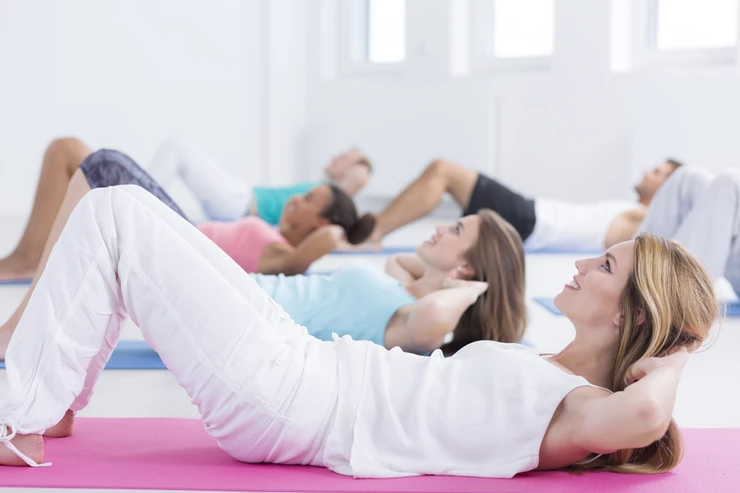Your body is feeling tense, tight, and you swear your core used to be so much stronger. So you start to look into exercise classes. Then you begin to talk to your friends about it and the recommendations start coming:
- “Oh Pilates is my FAVOURITE thing!”
- “Yoga has CHANGED my life”
- “Pilates has got me SO toned!”
- “Yoga has been GREAT for my back pain!”

And the comments go on! But every time you’ve looked at Pilates and Yoga, there seem to be nearly identical photos of people stretching in Lycra. So what on earth are they and what’s the difference?
We’ll start at the beginning, with a little history lesson….
Pilates
Pilates was developed by Joseph Pilates in the 1920s. Joseph was from Mönchengladbach, Germany and as a child, he suffered from a host of different illnesses. These early issues made him determined to achieve great physical and mental health. Joseph became an active gymnast, martial artist, skier and diver. During the First World War, he refined his own physical skills by teaching his techniques. Then towards the end of the war, he helped injured soldiers with their recovery and developed some of his most common methods.
Pilates and his wife, Clara, moved to the United States in the 1920s. Here they evolved and taught his techniques, then known as ‘Contrology’ in their ‘body-conditioning gym’. Contrology was a method of using the mind to manipulate the muscles in the exercises and Joseph and Clara built some loyal customers with his approach. The use of good posture, strength, flexibility, correct breathing and treating physical issues were the fundamentals of Joseph’s teachings.
Joseph passed away in 1967 and after this Contrology became the Pilates Method.
Yoga
There are no accurate records of exactly how old yoga is and exactly where it originated. But, approximately 3000 BC, yoga-like images were found on seals from the Indus Valley Civilization (a Bronze Age civilisation in South Asia). The word yoga comes from the Sanskrit word, yuj which means ‘to yoke’ and represents the connection between the body, mind and spirit.
The yoga sutras by Patanjali from approximately 2500 BC are said to be the oldest texts on the subject of yoga. In these texts, he describes the ‘cessation of the turnings of the mind’. This statement has evolved into being one of the most common goals of yoga: the calming of the mind and bringing a sense of inner peace. The sutras also spoke about the ‘Eight Limbs of Yoga’, the physical yoga exercises being just one of those limbs.
Yoga came to the West in the 1890s when Swama Vivekanada brought it to America. He travelled around the country for four years, talking about yoga and the philosophy of Hinduism.
So, What About the Actual Exercises? What Happens in Modern Pilates and Yoga Classes?
Pilates
A few versions of Pilates exist now but most are taught based on 9 main principles. These principles include correct breathing, focus, precise muscle control and working the “powerhouse” (core) muscles.
There are two main types of Pilates classes: mat classes or ‘reformer’ classes. The mat class is self-explanatory and is practised on a mat, like a yoga mat and focuses on body weight work. You will stretch, exercise and move the body in different ways to build strength and flexibility. Whilst a reformer class uses a moving platform with attached springs and pulleys, to help build strength.
Pilates focuses on core exercises but that doesn’t just mean working your abdominals. It includes back, hips and thighs, so you will get a full body workout.
Your teacher should guide you on the following:
- How to connect your naval and your spine
- How to keep a neutral spine, engaging your pelvic floor
- Engaging your abdominal muscles
- Keeping your scapula stable
- Controlling segments of the spine
- Thoracic breathing.
Yoga
Yoga classes can be a little complicated to summarise because there are a number of different kinds of yoga. The main variations are Vinyasa, Hatha, Iyengar, Kundalini, Ashtanga, Bikram Yin and Restorative yoga.
The common denominator between the exercise is that they will all:
- Strengthen and stretch the body as a whole.
- Focus on the breath as an aid for concentration and relaxation.
- Focus on calming the mind.
There is some focus on core work, like Pilates but most yoga classes will focus on the whole body or have classes themed on different areas.
Many yoga classes will finish with a guided relaxation. The aim of the physical poses of yoga (known as the asanas) is to prepare the mind for meditation.
There may also be a focus on yogic philosophies in the class. The history and background of yoga can hold different levels of importance, depending on the class you go to. Interlinked with that is the fact that some teachers may use Sanskrit words for the yoga postures. Other teachers may just throw them in here and there, or use all English words.
So What are the Similarities in Pilates and yoga?
- Building strength and balance in the body.
- The use of breath as a focus and aid.
- Some of the exercises are the same (though they have different names e.g. Open Leg Balance/Boat Pose, Swan/Cobra, Pilates Push-Up/Chaturanga Shell/Child’s Pose).
What are the main differences between Pilates and yoga?
- Pilates focuses more on conditioning and energising the body, strength without bulking, potential weight loss and a solid core.
- Yoga focuses more on integrating the body and mind and is often thought of as a ‘lifestyle’, not just a form of exercise.